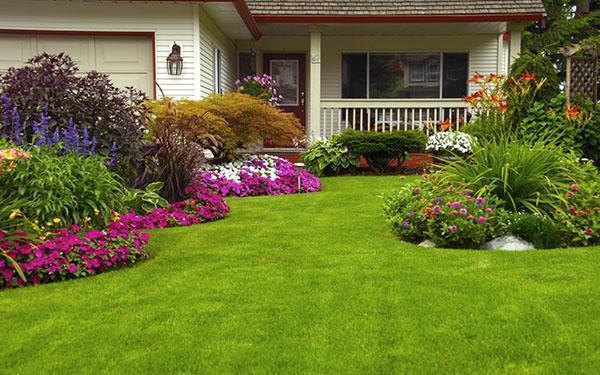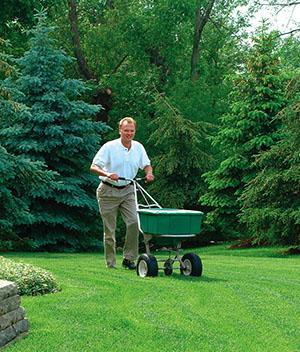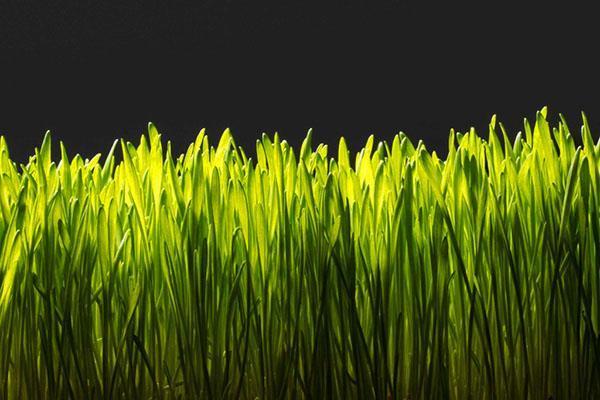Fertilizer for the lawn: features of fertilizing and the choice of funds
 The grass cover, without receiving additional care, watering or feeding, grows well, and sometimes becomes a problem for the owner of the site. But such unpretentiousness and self-sufficiency is valid only for wild-growing herbs.
The grass cover, without receiving additional care, watering or feeding, grows well, and sometimes becomes a problem for the owner of the site. But such unpretentiousness and self-sufficiency is valid only for wild-growing herbs.
If a lawn is broken on the backyard or in the garden, it becomes an area of constant attention.
Why fertilize your lawn?
There are several reasons for the loss of decorative lawn, dry grass, its fadedness and lack of growth. Among the main factors is a procedure aimed at maintaining a well-groomed site and nudging plants to form new foliage.
Bringing undoubted benefits, haircut is a serious injury, leading to the loss of some of the leaf plates and a decrease in the intensity of photosynthesis.

Therefore, apart from glaze and regular mowing, the grass cover needs additional feeding, and depending on the season, the needs of the plants for the elements obtained vary greatly.
How to fertilize the lawn in spring? How can you make it grow, maintain its beauty in the summer and prepare it for snowing?
The nutrients and trace elements that plants constantly need are contained in the soil. Intensively growing crops deplete the substrate, as a result of which the quality of the plants themselves deteriorates. This is especially noticeable in areas with perennial vegetation, which includes lawns.
Any lawn fertilizer is designed to:
- quickly overcome the consequences of a haircut or seasonal changes in the weather;
- maintain the tone of the grass;
- improve its decorative effect;
- to raise resistance to diseases, pests and weeds.
To replenish soil reserves, formulations are used that contain all the essentials for growth and development.
Read also the article: urea is like fertilizer!
What do lawn fertilizers contain?
 The main elements that all green plants need are phosphorus, potassium and nitrogen. If you refuse to fertilizers, soon yellow spots will be visible on the grass, the cover will become less juicy and thick.
The main elements that all green plants need are phosphorus, potassium and nitrogen. If you refuse to fertilizers, soon yellow spots will be visible on the grass, the cover will become less juicy and thick.
Nitrogen is necessary to maintain growth rates, foliage coloration and its constant renewal. Its plant receives and spends more than others, therefore it is extremely necessary to replenish the wasted amount.
The greatest need for this fertilizer is in the lawn in the spring, when the grass becomes active after the winter dormant period, the formation of leaves begins at the old rosettes, and root layers begin to grow. In the spring months, fertilizing with a nitrogen-containing composition is carried out at least twice. In summer, the demand for this element also does not decrease.
It is important to remember that by autumn the application of nitrogen fertilizers for the lawn must be stopped, otherwise an overabundance of this element may negatively affect the quality of the cover that goes under the snow.
Young shoots stimulated by nitrogen do not survive overwintering, rotting and causing the development of diseases throughout the area.As a result of the death of plants, the integrity and decorativeness of the coating is lost. And the owner of the lawn will have to work on the site rehabilitation and overseeding of the grass.
 The application of phosphorus fertilizers to the lawn in the spring makes the grass turn green earlier, makes its root system strong and branched. Plants that do not lack this element better tolerate summer heat and drought, and form new shoots more actively. Potassium has similar functions. It, like phosphorus, can be applied under the lawn grass or at the beginning of the season, in the spring, or already in the fall.
The application of phosphorus fertilizers to the lawn in the spring makes the grass turn green earlier, makes its root system strong and branched. Plants that do not lack this element better tolerate summer heat and drought, and form new shoots more actively. Potassium has similar functions. It, like phosphorus, can be applied under the lawn grass or at the beginning of the season, in the spring, or already in the fall.
It is rather difficult to calculate the optimal ratio of macronutrients in fertilizer for the lawn, and an incorrectly selected composition can bring harm to plantings rather than benefit. Therefore, experts advise using complex products designed for a specific season.
Fertika lawn fertilizer: top dressing from spring to autumn
 Complex fertilizers are developed taking into account all plant needs. Such formulations can be produced in granular form for application to the ground. Or the manufacturer provides for the need to dilute the agent, then feeding is carried out using a sprinkler.
Complex fertilizers are developed taking into account all plant needs. Such formulations can be produced in granular form for application to the ground. Or the manufacturer provides for the need to dilute the agent, then feeding is carried out using a sprinkler.
Liquid top dressing is a quick way to replenish nutrients. Granular lawn fertilizers have a longer effect, since the active substances do not enter the soil in full, but as individual particles dissolve. As a result, feeding can be done less often, without fear of deterioration in the quality of the soil and loss of decorativeness of the grass cover.
Today, gardeners have at their disposal tools in which the elemental composition is selected so that it exactly meets the needs of the grass in the spring-summer and autumn periods.
Fertik's lawn fertilizer is an example of this. The line for feeding lawn grasses includes two products that include the main macro- and microelements and are completely ready for use.
 This series of lawn fertilizer intended for use in spring:
This series of lawn fertilizer intended for use in spring:
- increases the density of the grass cover;
- improves the color, juiciness of the green part of plants;
- activates the growth of grass;
- helps the lawn to resist the growth of weeds, moss, pests and diseases;
- maintains the tone of plants and their resistance to adverse conditions.
The composition of the agent used for feeding includes nitrogen, phosphorus and potassium in an approximate ratio of 1: 1: 2. Not only does the agent added to the soil supply the plants with basic elements, it replenishes the substrate with a set of important trace elements. In spring, lawn fertilizer is applied as soon as the soil is free of snow. The last treatment is carried out in August. And then, according to the requirements of the plant, you will have to change the composition.
 The main share of nitrogen should enter the soil in spring and summer, for this reason, in the second fertilizer for Fertik's lawn, intended for autumn, its amount is halved, but the share of phosphorus and potassium.
The main share of nitrogen should enter the soil in spring and summer, for this reason, in the second fertilizer for Fertik's lawn, intended for autumn, its amount is halved, but the share of phosphorus and potassium.
This selection of components helps:
- strengthening the immunity of the lawn grass;
- better accumulation of nutrients, which are extremely necessary in the autumn-winter period;
- completely preserve the lawn and even improve its quality next season.
This complex composition is used not only for autumn feeding from August to November, it will be useful when laying a new section of the lawn.
How to fertilize the lawn?
 Asking the question: “How to fertilize the lawn in spring?”, Many gardeners forget about the correct feeding.
Asking the question: “How to fertilize the lawn in spring?”, Many gardeners forget about the correct feeding.
Any, even the most effective, means will be useless if fertilizer gets into the soil in unsuitable weather or if it spreads unevenly over the soil.
No matter how feeding is carried out, manually or using mechanized means, it is important to be guided by several rules:
- Spring feeding is carried out when the snow has completely melted, and the lawn will be cleared of last year's withered vegetation and foliage.
- During the rapid growth of grass, fertilizer for the lawn is applied after every second haircuts, while making two passes along and across the site, using half the required volume of granules.
- After each treatment of the lawn, the area is watered, but during the rain it is better to temporarily refuse feeding. Fertilizer contact with wet foliage threatens to damage the leaf plates. The same danger exists in hot, dry periods.
 During the season, the lawn, depending on its type, the intensity of wear of the grass cover, soil composition and other factors, may require from one to five additional fertilizing. Fertilizers for the lawn are always applied after mowing, and the last treatment is best done a couple of weeks before the onset of stable cold weather.
During the season, the lawn, depending on its type, the intensity of wear of the grass cover, soil composition and other factors, may require from one to five additional fertilizing. Fertilizers for the lawn are always applied after mowing, and the last treatment is best done a couple of weeks before the onset of stable cold weather.
Since fertilizers are a chemically active product, it is better to restrict the access of children and pets to the grass until the granules have dissolved and got into the ground. This will eliminate the risk of poisoning, unwanted skin reactions and other problems.